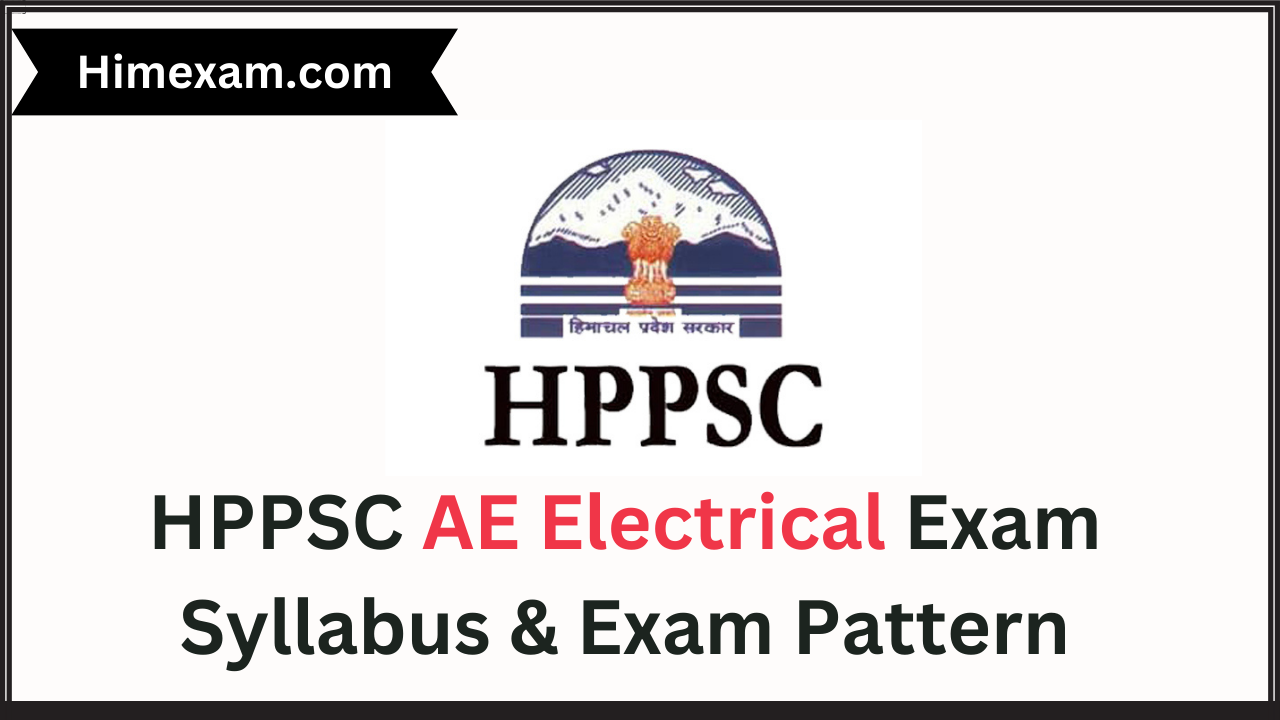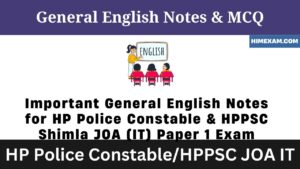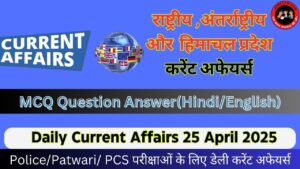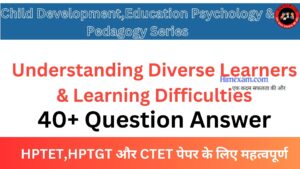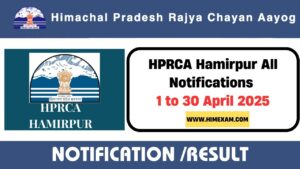HPPSC AE (Electrical) Exam Syllabus & Exam Pattern:-Apropos of this Commission’s advertisements No. 21/11-2023 dated 03.11.2023, 22/11-2023 dated 04.11.2023, 26/11-2023 dated 18.11.2023 & 25/11-2023 dated 07.11.2023 vide which posts of Assistant Law Officer, Class-II (on contract basis) in H.P. State Pollution Control Board under the Department of Environment, Science & Technology, H.P., Assistant Engineer (Electrical) and Assistant Engineer (Civil) Class-I (on contract basis) in HIMUDA under the Department of Housing H.P. and Assistant Manager (Law), Class-II (on regular basis) in H.P. State Co-operative Agriculture and Rural Development Bank under the Department of Cooperation, H.P. respectively were advertised to invite Online Recruitment Applications from eligible and desirous candidates for making direct recruitment in Himachal Pradesh. In these advertisements, it was mentioned that syllabus & Pattern of Examination will be notified separately. Now after due approval of the Commission, the Syllabus & Examination Pattern of both the papers i.e. I & II for the said posts are notified as under:-
HPPSC AE (Electrical) Exam Syllabus & Exam Pattern Overview:-
| Paper I | Paper II |
|---|---|
| Objective type Multiple Choice Questions (MCQ). Based on the merit of Paper-I, the answer sheets of Paper-II of the candidates, 20 times of the total number of the vacancies to be filled up, shall be evaluated. No candidate securing zero or negative marks in Paper-I shall form part of the merit list | Descriptive Subject Aptitude Test (SAT) Minimum pass marks in the Subject Aptitude Test (SAT) to qualify for the Personality Test shall be 35% for the candidates of General category and 30% for the candidates of reserved categories. Marks obtained by the candidates in the main examination (written part as well as Personality Test) would determine their final ranking. In the event of a tie, order of merit shall be determined in accordance with highest marks secured in the Personality Test and in case the marks in the Personality Test of the candidates are also equal, then the candidate securing more marks in Paper -I will be placed above the candidate securing less marks in the same. In case the marks of Paper -I are also equal, then the candidate who is older in age will be placed above the candidate younger in age. In case the age is also same then the candidate having more marks in the essential qualification examination will be placed above the candidate having less marks. |
| 50 Questions | 08 questions in all, out of which 06 have to be attempted by selecting atleast 03 questions from each part i.e. Part-I & Part-II. |
| 100 Marks | 120 Marks |
| 01 Hour duration | 03 Hour duration |
Marking Scheme:-In offline Test (objective type) each question will be followed by four (A, B, C, D) answer options and one option “E” in case candidate does not want to answer the question. The candidate will have to encircle / blacken with blue / black ball pen the option he / she thinks is correct in OMR answer sheet. No answer will be left blank. In case the candidate does not want to answer a question to avoid negative marking he/she shall have to encircle / blacken the option “E”. If any answer is left blank and none of the option is encircled then it will also result in negative marking. There shall be negative marking in all the objective type screening tests / examinations as under:- (a) For each question for which a wrong answer has been given by the candidate, one fourth (0.25) of the marks assigned to that question will be deducted as penalty. (b) If a candidate gives more than one answer, it will be treated as a wrong answer even if one of the given answers happens to be correct and there will be same penalty as above for that question also i.e. one fourth (0.25) of the marks assigned to that question will be deducted as penalty. (c) If a question is left blank i.e. no circle is clicked or encircled / blackened by the candidate, there will be same penalty as above for that question also i.e. one fourth (0.25) of the marks assigned to that question will be deducted as penalty. (d) Where there are two correct answers instead of one correct answer out of four options of a question, all those candidates who will click or encircle / blacken any one of these two correct answers will be awarded marks allotted to that question. Note-I:- In respect of the scrapped question(s) no credit to appeared candidates shall be given and passing marks will accordingly be proportionally reduced. Note-II:- In case of bilingual papers, if there is any difference in English and Hindi version of the question and answer option, the English version shall be treated as correct and final
Syllabus:-
Part I(60 Marks):-
1.Electrical Materials:- Electrical Engineering Materials, crystal structures and defects, ceramic materials, insulating materials, magnetic materials-basics, properties and applications; ferrities, ferro-magnetic materials and components; basics of solid state physics, conductors; Photo-conductivity; Basics of Nano materials and Superconductors.
2. Electric Circuits and Fields:- Circuit elements, network graph, KCL, KVL, Node and Mesh analysis, ideal current and voltage sources, Thevenin’s, Norton’s, Superposition and Maximum Power Transfer theorems, transient response of DC and AC networks, Sinusoidal steady state analysis, basic filter concepts, two-port networks, three phase circuits, Magnetically coupled circuits, Gauss Theorem, electric field and potential due to point, line, plane and spherical charge distributions, Ampere’s and Biot-Savart’s laws; inductance, dielectrics, capacitance; Maxwell’s equations.
3. Electrical and Electronic Measurements:- Principles of measurement, accuracy, precision and standards; Bridges and potentiometers; moving coil, moving iron, dynamometer and induction type instruments, measurement of voltage, current, power, energy and power factor, instrument transformers, digital voltmeters and multi-meters, phase, time and frequency measurement, Q-meters, oscilloscopes, potentiometric recorders, error analysis, Basics of sensors, Transducers, basics of data acquisition systems. Basics of house wiring, Testing of domestic electric wiring installation.
4. Computer Fundamentals:: Number systems, Boolean algebra, arithmetic functions, Basic Architecture, Central Processing Unit, 1/0 and Memory Organisation; peripheral devices, data representation and programming, basics of Operating system and networking virtual memory, file systems; Elements of programming languages, typical examples.
5. Basic Electronics Engineering: Basics of Semiconductor diodes and transistors and characteristics, Junction and field effect transistors (BJT, FET and MOSFETS), different types of transistor amplifiers, equivalent circuits and frequency response; oscillators and other circuits, feedback amplifiers.
Part II (60 Marks)
1.Analog and Digital Electronics:- Operational amplifiers- characteristics and applications, combinational and sequential logic circuits, multiplexers, multi-vibrators, sample and hold circuits, A/D and D/A converters, basics of filter circuits and applications, simple active filters; Microprocessor basics- interfaces and applications, basics of linear integrated circuits; Analog communication basics, Modulation and de-modulation, noise and bandwidth, transmitters and receivers, signal to noise ratio, digital communication basics, sampling, quantizing coding, frequency and time domain multiplexing, power line carrier communication systems.
2. Systems and Signal Processing: Representation of continuous and discrete-time signals, shifting and scaling operations, linear, time-invariant and causal systems, Fourier series representation of continuous periodic signals, sampling theorem, Fourier and Laplace transforms, Z transforms, Discrete Fourier transform, FFT, linear convolution, discrete cosine transform, FIR filter, IIR filter, Bilinear transformation.
3. Control Systems:: Principles of feedback, transfer function, block diagrams and signal flow graphs, steady-state errors, transforms and their applications; Routh-hurwitz criterion, Nyquist techniques, Bode plots, root loci, lag, lead and lead-lag compensation, stability analysis, transient and frequency response analysis, state space model, state transition matrix, controllability and observability, linear state variable feedback, PID and industrial controllers.
4.Electrical Machines:- Single phase transformers, three phase transformers- connections, parallel operation, auto- transformer, energy conversion principles, DC machines-types, windings, generator characteristics, armature reaction and commutation, starting and speed control of motors, Induction motors- principles, types, performance characteristics, starting and speed control, Synchronous machines- performance, regulation, parallel operation of generators, motor starting, characteristics and applications, servo and stepper motors.
5. Power Systems:- Basic power generation, concepts, steam, gas and water turbines, transmission line models and performance, cable performance, insulation, corona and radio interference, power factor correction, symmetrical components, fault analysis, principles of protection systems, basics of solid state relays and digital protection; Circuit breakers, Radial and ring-main distribution systems, Matrix representation of power systems, load flow analysis, voltage control and economic operation, System stability concepts, Swing curves and equal area criterion, HVDC transmission and FACTS concepts, Concepts of power system dynamics, distributed generation, solar and wind power, smart grid concepts, environmental implications, fundamentals of power economics. Load flow studies, Gauss-Siedel and Newton Raphson methods.
6. Power Electronics and Drives:- Semiconductor power diodes, transistors, thyristors, triacs, GTOs, MOSFETs and IGBTs- static characteristics and principles of operation, triggering circuits, phase control rectifiers, bridge converters-fully controlled and half controlled, principles of choppers and inverters, basic concepts of adjustable speed DC and AC drives, DC-DC switched mode converters, DC-AC switched mode converters, resonant converters, high frequency inductors and transformers, power supplies.
4. Electrical Machines:- Single phase transformers, three phase transformers- connections, parallel operation, auto- transformer, energy conversion principles, DC machines-types, windings, generator characteristics, armature reaction and commutation, starting and speed control of motors, Induction motors- principles, types, performance characteristics, starting and speed control, Synchronous machines- performance, regulation, parallel operation of generators, motor starting, characteristics and applications, servo and stepper motors.
5. Power Systems:- Basic power generation, concepts, steam, gas and water turbines, transmission line models and performance, cable performance, insulation, corona and radio interference, power factor correction, symmetrical components, fault analysis, principles of protection systems, basics
More Pages:-
हेलो दोस्तों ,आपका हमारी वेबसाइट Himexam.com पर स्वागत है। जैसा की आपको पता है हमारी वेबसाइट Himexam.com आपको समय-समय पर सभी HP Govt Jobs & All India Govt Jobs की Notifications प्रदान करवाती है। साथ ही साथ Himachal Pradesh Exam Previous Paper और Himachal Pradesh GK ,Himachal Pradesh & National +International Current Affairs के सभी नोट्स मुफ्त उपलब्ध करवाते है। हमारी वेबसाइट के अलग अलग प्लेटफार्म पर pages & Group बने है जैसे की facebook ,Telegram और Instagram .. अगर आप हिमाचल के किसी भी पेपर की तैयारी कर रहे हो तो जल्दी से इन groups के साथ जुड़ जाएं इनके लिंक नीचे table में दिए गए है।
Join Us:-
| Like Our Facebook Page | Click here |
| Join Us oN Telegram | Click here |
| Join Us On Instagram | Click Here |

